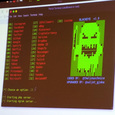How a Teenager Can Hack Your Law Firm
At an ILTACON session, a 15-year-old ethical hacker showed just how easy it is to target law firms and attorneys in today's cybersecurity world.
August 21, 2018 at 02:26 PM
4 minute read
 “White Hat” hacker Marcus Weinberger, 15, showing off his hacking chops at ILTACON 2018. Photo: Rhys Dipshan/ALM
“White Hat” hacker Marcus Weinberger, 15, showing off his hacking chops at ILTACON 2018. Photo: Rhys Dipshan/ALM
While corporations and law firms have been successfully infiltrated by well-trained nation state cybercriminals with unique hacking resources at their disposal, these are far from the only hackers that may be able to breach today's cyber defenses.
Given the wide availability of hacking tools and resources, even those with little experience can comprise a company's IT and web assets. Just ask Marcus Weinberger, a 15-year-old ethical hacker and son of Ben Weinberger, lawyer in residence at Prosperoware.
Marcus Weinberger, the young presenter at the “Watch a 15 Year Old Hack Your Firm's Users” session at ILTACON 2018, only got into ethical hacking recently, and is in the midst of learning some coding languages, such as Python.
But by using widely available resources like Google and GitHub, and purchasing a few relatively inexpensive tools, he has been able to learn just how easily one can infiltrate a law firm's web assets and employees.
 Photo: Rhys Dipshan
Photo: Rhys DipshanWeinberger noted that some of the hardware tools he uses as an ethical hacker include “a wireless development board usually used for IT projects and home automation,” and a WiFi Pineapple device, which is “basically a tinny wireless router used for wireless penetration testing” that can be leveraged for “man-in-the-middle” attacks. While WiFi Pineapple devices can be expensive, many of the others tools can usually be bought for under $10.
To be sure, the tools Weinberger used, and the resources he relied on to learn how to use them, are far from secret. “This is not the dark web we are talking about here. All tools are all readily available to anyone here,” he noted.
There are a few types of cyberattacks noted that are fairly simple for hackers to executive. Web attacks, for example, can leverage SQL injections, which is a code technique to access a website or web application's database server to get a hold of information including password and login data.
Indeed, one can even search on Google for websites that run on programming languages like SQL or PHP to know how best to target them. “Just by finding that particular string in the URL identifies what that website is running on,” Weinberger said.
Today's hackers can also automate web attacks by using available pre-written scripts so they don't need to know how to code or create web hacking tools from scratch.
While web attacks can be easy, they may not be as devastating as the slightly more involved Wi-Fi attacks. By using Wifi Pineapple devices and related tools, for instance, hackers can access many devices connected to public, unsecured networks.
“At one point my family and I were on holiday somewhere and we were in a Walmart getting some food,” Weinberger recalled. “And my phone is rooted [which means] I can do some hacking stuff on there, and I realized I could do a 'man-in-the-middle' attack on Walmart's public Wi-Fi.”
Wi-Fi attacks are also menacing because they can trick consumer devices into automatically connecting to a malicious network without the device's user knowing.
“When your phone scans for Wi-Fi it will send out a list of networks it is looking for … and what devices do is notice that list and respond, and your phone will automatically connect to those.” By spoofing a Wi-Fi network to mimic the name of a common network that devices will likely recognize and connect to, hackers can then comprise many devices, including personal devices used by law firm employees.
And instead of relying on technical exploits, Weinberger noted that hackers can also trick users into infecting their own computers with malware by executing automated phishing attacks.
One tool he found, for example, will send a Twitter user “a direct tweet from an account they are familiar with, and the tweet can include a phishing URL” that mimics a well-known link, but is really a malicious link. All one needs to do is create a fake Twitter account and get followed by some of their targets.
This content has been archived. It is available through our partners, LexisNexis® and Bloomberg Law.
To view this content, please continue to their sites.
Not a Lexis Subscriber?
Subscribe Now
Not a Bloomberg Law Subscriber?
Subscribe Now
NOT FOR REPRINT
© 2025 ALM Global, LLC, All Rights Reserved. Request academic re-use from www.copyright.com. All other uses, submit a request to [email protected]. For more information visit Asset & Logo Licensing.
You Might Like
View AllTrending Stories
- 1Public Notices/Calendars
- 2Wednesday Newspaper
- 3Decision of the Day: Qui Tam Relators Do Not Plausibly Claim Firm Avoided Tax Obligations Through Visa Applications, Circuit Finds
- 4Judicial Ethics Opinion 24-116
- 5Big Law Firms Sheppard Mullin, Morgan Lewis and Baker Botts Add Partners in Houston
Who Got The Work
J. Brugh Lower of Gibbons has entered an appearance for industrial equipment supplier Devco Corporation in a pending trademark infringement lawsuit. The suit, accusing the defendant of selling knock-off Graco products, was filed Dec. 18 in New Jersey District Court by Rivkin Radler on behalf of Graco Inc. and Graco Minnesota. The case, assigned to U.S. District Judge Zahid N. Quraishi, is 3:24-cv-11294, Graco Inc. et al v. Devco Corporation.
Who Got The Work
Rebecca Maller-Stein and Kent A. Yalowitz of Arnold & Porter Kaye Scholer have entered their appearances for Hanaco Venture Capital and its executives, Lior Prosor and David Frankel, in a pending securities lawsuit. The action, filed on Dec. 24 in New York Southern District Court by Zell, Aron & Co. on behalf of Goldeneye Advisors, accuses the defendants of negligently and fraudulently managing the plaintiff's $1 million investment. The case, assigned to U.S. District Judge Vernon S. Broderick, is 1:24-cv-09918, Goldeneye Advisors, LLC v. Hanaco Venture Capital, Ltd. et al.
Who Got The Work
Attorneys from A&O Shearman has stepped in as defense counsel for Toronto-Dominion Bank and other defendants in a pending securities class action. The suit, filed Dec. 11 in New York Southern District Court by Bleichmar Fonti & Auld, accuses the defendants of concealing the bank's 'pervasive' deficiencies in regards to its compliance with the Bank Secrecy Act and the quality of its anti-money laundering controls. The case, assigned to U.S. District Judge Arun Subramanian, is 1:24-cv-09445, Gonzalez v. The Toronto-Dominion Bank et al.
Who Got The Work
Crown Castle International, a Pennsylvania company providing shared communications infrastructure, has turned to Luke D. Wolf of Gordon Rees Scully Mansukhani to fend off a pending breach-of-contract lawsuit. The court action, filed Nov. 25 in Michigan Eastern District Court by Hooper Hathaway PC on behalf of The Town Residences LLC, accuses Crown Castle of failing to transfer approximately $30,000 in utility payments from T-Mobile in breach of a roof-top lease and assignment agreement. The case, assigned to U.S. District Judge Susan K. Declercq, is 2:24-cv-13131, The Town Residences LLC v. T-Mobile US, Inc. et al.
Who Got The Work
Wilfred P. Coronato and Daniel M. Schwartz of McCarter & English have stepped in as defense counsel to Electrolux Home Products Inc. in a pending product liability lawsuit. The court action, filed Nov. 26 in New York Eastern District Court by Poulos Lopiccolo PC and Nagel Rice LLP on behalf of David Stern, alleges that the defendant's refrigerators’ drawers and shelving repeatedly break and fall apart within months after purchase. The case, assigned to U.S. District Judge Joan M. Azrack, is 2:24-cv-08204, Stern v. Electrolux Home Products, Inc.
Featured Firms
Law Offices of Gary Martin Hays & Associates, P.C.
(470) 294-1674
Law Offices of Mark E. Salomone
(857) 444-6468
Smith & Hassler
(713) 739-1250






